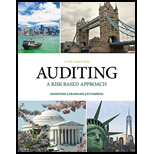
a.
Introduction: Audit is the activity performed by the professional known as the auditor. In audit the validity and reliability of the information given by the company is correct of not. True and fair view of the books of accounts is shown in the
The statistical conclusion if no misstatements are found in the sample and whether its account balance acceptable.
b.
Introduction: Audit is the activity performed by the professional known as the auditor. In audit the validity and reliability of the information given by the company is correct of not. True and fair view of the books of accounts is shown in the balance sheet of the company and annually present to the shareholder and boards of director of the company.
Compute the total estimated misstatements.
c.
Introduction: Audit is the activity performed by the professional known as the auditor. In audit the validity and reliability of the information given by the company is correct of not. True and fair view of the books of accounts is shown in the balance sheet of the company and annually present to the shareholder and boards of director of the company.
The results indicates the account balance as acceptable.
d.
Introduction: Audit is the activity performed by the professional known as the auditor. In audit the validity and reliability of the information given by the company is correct of not. True and fair view of the books of accounts is shown in the balance sheet of the company and annually present to the shareholder and boards of director of the company.
If results are not acceptable other course of action available to the auditor.
Want to see the full answer?
Check out a sample textbook solution
Chapter 8 Solutions
Auditing: A Risk Based-Approach (MindTap Course List)
- For Ikea Manufacturing, the predetermined overhead rate is 125% of direct labor cost. During the month, Ikea incurred $96,000 in total factory labor costs, of which $78,400 is direct labor and $17,600 is indirect labor. The actual manufacturing overhead incurred was $100,500. Compute the amount of manufacturing overhead applied during the month. Determine the amount of under- or overapplied manufacturing overhead.arrow_forwardProvide Solution?arrow_forwardSolve this questions Financial accountingarrow_forward
 Auditing: A Risk Based-Approach (MindTap Course L...AccountingISBN:9781337619455Author:Karla M Johnstone, Audrey A. Gramling, Larry E. RittenbergPublisher:Cengage Learning
Auditing: A Risk Based-Approach (MindTap Course L...AccountingISBN:9781337619455Author:Karla M Johnstone, Audrey A. Gramling, Larry E. RittenbergPublisher:Cengage Learning Auditing: A Risk Based-Approach to Conducting a Q...AccountingISBN:9781305080577Author:Karla M Johnstone, Audrey A. Gramling, Larry E. RittenbergPublisher:South-Western College Pub
Auditing: A Risk Based-Approach to Conducting a Q...AccountingISBN:9781305080577Author:Karla M Johnstone, Audrey A. Gramling, Larry E. RittenbergPublisher:South-Western College Pub Essentials of Business Analytics (MindTap Course ...StatisticsISBN:9781305627734Author:Jeffrey D. Camm, James J. Cochran, Michael J. Fry, Jeffrey W. Ohlmann, David R. AndersonPublisher:Cengage Learning
Essentials of Business Analytics (MindTap Course ...StatisticsISBN:9781305627734Author:Jeffrey D. Camm, James J. Cochran, Michael J. Fry, Jeffrey W. Ohlmann, David R. AndersonPublisher:Cengage Learning


